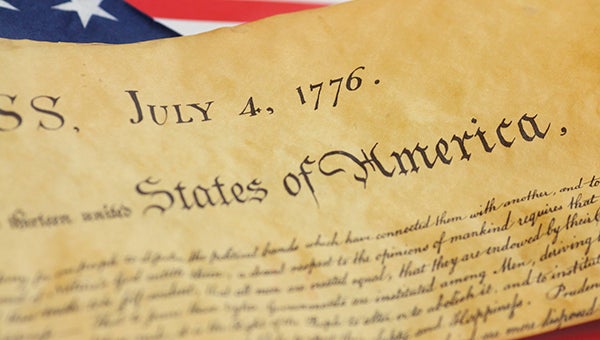From 1776 to 2014, fast facts about the Fourth of July
Published 7:25 am Friday, July 4, 2014
On this day in 1776, the Continental Congress approved the Declaration of Independence, setting the 13 colonies on the road to freedom as a sovereign nation. As always, this most American of holidays will be marked with red, white and blue flags, fireworks, parades and backyard barbecues across the country. Here are facts about the Fourth of July compiled by the U.S. Census Bureau.
2.5 million
In July 1776, the estimated number of people living in the newly independent nation.
318.4 million
The nation’s estimated population on this July Fourth.
56
Numbers of signers to the Declaration of Independence.
Benjamin Franklin, John Adams, Thomas Jefferson, Roger Sherman and Robert R. Livingston comprised the Committee of Five that drafted the Declaration. Jefferson, regarded as the strongest and most eloquent writer, wrote most of the document.
$203.6 million
The value of fireworks imported from China in 2013, representing the bulk of all U.S. fireworks imported ($213.8 million). U.S. exports of fireworks, by comparison, came to just $10.2 million in 2013, with Israel purchasing more than any other country ($2.7 million).
$4.0 million
In 2013, the dollar value of U.S. imports of American flags. The vast majority of this amount ($3.9 million) was for U.S. flags made in China.
$781,222
Dollar value of U.S. flags exported in 2013. The Dominican Republic was the leading customer, purchasing $160,000 worth.
59
Fifty-nine places contain the word “liberty” in the name. Pennsylvania, with 11, has more of these places than any other state. Of the 59 places, four are counties: Liberty County, Ga. (64,135), Liberty County, Fla. (8,349), Liberty County, Mont. (2,369) and Liberty County, Texas (76,907).
1
One place has “patriot” in its name: Patriot, Ind., has an estimated population of 205.
The most common patriotic-sounding word used within place names is “union” with 136. Pennsylvania, with 33, has more of these places than any other state. Other such words most commonly used in place names are Washington (127), Franklin (118) and Lincoln (95).
$100 billion
Dollar value of trade in 2013 between the United States and the United Kingdom, making the British, our adversary in 1776, our seventh-leading trading partner today.
62.9 million
Total estimated number of hogs and pigs as of March 1, 2014. Chances are that the pork hot dogs and sausages consumed on the Fourth of July originated in Iowa. The Hawkeye State was home to an estimated 19.8 million hogs and pigs. North Carolina (estimated at 8.0 million) and Minnesota (estimated at 7.8 million) were also homes to large numbers of pigs.
220,521
The number of paid employees (for the pay period including March 12) who worked in a poultry-processing establishment in the U.S. in 2012. There were 517 such establishments — California (45) had the most. Georgia has the most establishments with greater than 1,000 employees (13), followed by Arkansas (11) and North Carolina (8).
6.1 billion pounds
Total estimated production of cattle and calves in Texas in 2013. There is a good chance that the beef hot dogs, steaks and burgers on your backyard grill came from the Lone Star State, which accounted for nearly one-sixth of the nation’s total production. And if the beef did not come from Texas, it very well may have come from Nebraska (estimated at 5.1 billion pounds) or Kansas (estimated at 3.7 billion pounds).
Fast facts about the signing of the Declaration of Independence
• John Hancock, President of the Second Continental Congress, was the first signer. This merchant by trade did so in an entirely blank space making it the largest and most famous signature — hence the term John Hancock, which is still used today as a synonym for signature. There are 7.4 million businesses with paid employees in the U.S., of those establishments 1 million are in the retail trade industry.
• Benjamin Franklin (age 70), who represented Pennsylvania, was the oldest of the signers. Franklin County, Pa., had an estimated population of 152,085 as of July 1, 2013. Edward Rutledge (age 26), of South Carolina, was the youngest.
• Two future presidents signed, John Adams (second President) and Thomas Jefferson (third President). Both died on the 50th anniversary of signing the Declaration (July 4, 1826). There are 12 counties nationwide named Adams and 26 named Jefferson.
• Robert Livingston, who represented New York, was on the Committee of Five that drafted the Declaration of Independence but was recalled by his state before he could sign it. Livingston County, N.Y., was home to an estimated 64,705 people as of July 1, 2013.
• Representing Georgia in 1776 were Button Gwinnett, Lyman Hall and George Walton. Gwinnett County, Ga. (859,304), Hall County, Ga. (187,745) and Walton County, Ga. (85,754) were named for these signers.
• Charles Carroll, who represented Maryland, was the last surviving signer of the Declaration. He died in 1832 at the age of 95. Carroll County, Md., named for him, had an estimated population of 167,564 as of July 1, 2013.
• Roger Sherman, who worked as a land surveyor and lawyer, represented Connecticut. Nationally in 2012, there were an estimated 29,976 surveyors, cartographers and photogrammetrists employed full time, year-round, and 841,077 lawyers employed full time, year-round nationwide.
• Nelson County, Va. (14,789) and Wythe County, Va. (29,344) were named for two of the six signers who represented the state of Virginia — Thomas Nelson Jr. and George Wythe.






